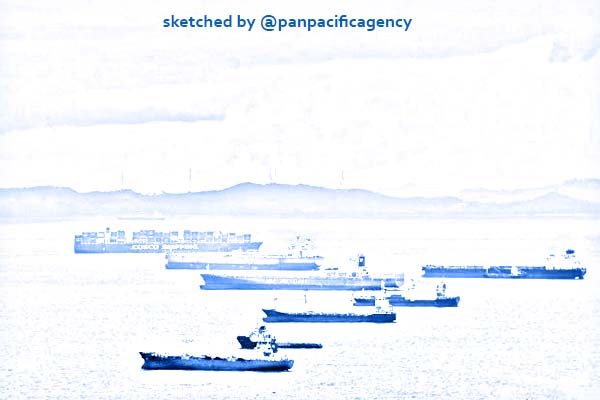Skyrocketing freight costs having detrimental impact on small and medium exporters: Report

Cargo ships in the South China Sea. PHOTO: SPH/Kua Chee Siong. Sketched by the Pan Pacific Agency.
NEW DELHI, Jun 13, 2021, FE. While the Suez Canal blockage in March 2021 underscored different challenges faced by the shipping and logistics industry, SMBs particularly have been going through a more profound and widespread crisis since the onset of the Covid pandemic and the resulting economic contraction, the report noted, Financial Express reported.
Rising freight costs over the last year due to the shortage of shipping containers are having a detrimental impact on small and medium-sized exporters, said a new report. As of June 10, 2021, Drewry’s composite World Container Index (WCI) — a global index for container spot market freight rates on all the major routes, peaked at $6727, up by over 300 per cent since the emergence of the coronavirus in December 2019, trade finance company Drip Capital said in its report Global Shipping Crisis. As per its internal analysis, SMBs globally have more than 25 per cent share of the $18 trillion maritime trade. While the Suez Canal blockage in March 2021 uncerscored different challenges faced by the shipping and logistics industry, SMBs particularly have been going through a more profound and widespread crisis since the onset of the COVID-19 pandemic and the resulting economic contraction, the company said.
“In March 2020, with social distancing protocols and coronavirus clusters amongst dockworkers (meant slower shipment processing times), there emerged a shortage of containers in Asia as empty metal boxes were stranded at North American and European ports,” the report noted. The situation of container shortage got quite out of hand in November 2020, such that the container availability index (CAx) for “Forty Foot Equivalent Units reached 0.9 as containers were piling up at the port of Los Angeles (LA).” CAx is a measure ranging between 0 and 1 that reveals the number of containers that leave and enter a port in the same week. Low CAx values indicate a deficit of containers while high values indicate a surplus of containers.
“We are planning our shipments well in advance than we used to a year ago. Still, container availability has been an issue. When the goods are sitting ready for two to three weeks, we don’t get an empty container to have the goods shipped to us from India. This has been affecting our sales and delaying our collections,” the report cited Vivek Pandit, CEO, Indian Foods and Spices — an SMB wholesale importer from the US of Indian food items.
Enterprises that were desperate to export their goods abroad meant paid premium rates to acquire containers which had increased the shipping costs with Drewry’s composite WCI rising from $2628 at the start of November 2020 to $5340 in January 2021. “It became harder for US exporters to get containers because of China’s aggressive tactics to bring back empty containers. This competitive environment affected many but especially all the SMB exporters who were burdened by these high costs,” the report said.